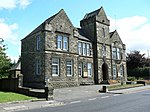Bonnybridge

Bonnybridge (Scottish Gaelic: Drochaid Bhunaich; Scots: Bonniebrig) is a village in the Falkirk council area of Scotland. It is 4.0 miles (6.4 km) west of Falkirk, 5.3 miles (8.5 km) north-east of Cumbernauld and 8.3 miles (13.4 km) south-southwest of Stirling. The village is situated near the Bonny Water which runs through the town and lies north of the Forth and Clyde Canal. To the south-east of Bonnybridge is a well-preserved section of the Antonine Wall, and the remnants of Rough Castle Fort, the most complete of the surviving Roman forts of the wall. According to the 2001 Census, the population stands at 6,870 residents. However, the Bonnybridge settlement area, which includes Banknock, Denny, Dunipace and Haggs has a total population of around 24,370.
Excerpt from the Wikipedia article Bonnybridge (License: CC BY-SA 3.0, Authors, Images).Bonnybridge
Seabegs Road,
Geographical coordinates (GPS) Address Nearby Places Show on map
Geographical coordinates (GPS)
| Latitude | Longitude |
|---|---|
| N 55.999 ° | E -3.887 ° |
Address
Seabegs Road
Seabegs Road
FK4 2BX
Scotland, United Kingdom
Open on Google Maps






